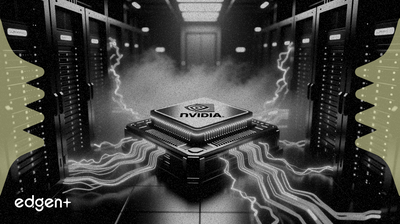
No Data Yet

## エグゼクティブサマリー **Iris Energy (IREN)** は、ビットコイン採掘から人工知能インフラへの重要な戦略的転換を進めており、これは **Microsoft** との数十億ドル規模のクラウド契約によって裏打ちされています。この動きは、IRENをGPUを活用したコンピューティングの急増する需要に乗せるものですが、同時にかなりの財務リスクも伴います。同社は2026年までに14万台のGPUを導入する計画であり、**Microsoft** との契約だけで推定58億ドルの設備投資が必要です。この資本集約的な拡大は、特に高水準の負債と、ハイパースケーラーが戦略的に切り離そうとしている財務リスクを吸収するビジネスモデルの長期的な持続可能性に関して、投資家の監視を招いています。 ## イベントの詳細 IRENの事業拡大は、AI分野における爆発的な成長への直接的な対応であり、専門的なデータセンター容量に対する飽くなき需要を生み出しています。同社は、AIクラウドインフラを提供するために **Microsoft** と100億ドル規模の契約を結びました。この契約には、**NVIDIA** GPUの大規模な調達と展開が含まれています。この転換により、IRENは「ネオクラウド」として知られる新しいクラスのデータセンタープロバイダーに位置づけられます。これらのエンティティは、多くの場合、3年から5年の柔軟な短期契約を通じて、テクノロジー大手企業に大規模なコンピューティングパワーを提供することに焦点を当てています。この取り決めにより、**Microsoft**のようなハイパースケーラーは、容量を長期的な設備投資ではなく運用費用として扱うことができ、その結果、バランスシートに大きな影響を与えることを回避できます。 ## 市場への影響 市場は、AIインフラブームの財務基盤についてますます慎重になっています。**Oracle (ORCL)** や **Broadcom (AVGO)** といった企業は、AI主導の強い需要にもかかわらず株価が下落しており、投資家は高い負債負担と利益率圧縮の可能性に疑問を呈しています。例えば、**Broadcom** の経営陣は、AI関連収益の比率が高まると、フルラック規模のシステム販売に関連するコストのため、粗利益率が100ベーシスポイント圧縮されると警告しました。IRENは、財務モデルが厳しく精査される市場に参入しており、その株価パフォーマンスは、これらの利益率圧力に直面して、重い負債と設備投資を管理する能力に密接に関連する可能性が高いです。 ## 専門家のコメント 金融アナリストは、テクノロジー大手が採用している戦略を巧妙なリスク転嫁と見ています。「他人の資金」(OPM)を使用することで、**Microsoft** や **Meta** といった企業は、数十年にわたるコミットメントに縛られることなく、AI能力を迅速に拡大できます。Zacks Investment Researchの株式アナリスト、Andrew Roccoは、「Metaの戦略の重要な部分は、私の見解では、業界がOPMと呼ぶものを使って可能な限りこれを構築することです」と述べました。**Microsoft** の最高経営責任者であるSatya Nadellaは、柔軟性の必要性を強調し、需要が変化した場合に「逆さまになりたくない」と述べています。これは、ハイパースケーラーの顧客が契約を更新しないことを選択した場合に、長期的な資産と関連する負債が残されるIRENのようなネオクラウドプロバイダーに責任を負わせるものです。 ## より広範な文脈 IRENと **Microsoft** の契約は、テクノロジーの最大手企業がAI構築の財務リスクを切り離しているという、より広範な業界トレンドの事例研究です。**Meta** は、負債を直接負うことなくルイジアナ州のデータセンターに資金を供給するために設立された特別目的会社「Beignet Investor LLC」で同様の戦略を採用しました。プライベートクレジット会社も関与するこれらの創造的な資金調達構造は、テクノロジー大手が財務の機敏性を維持することを可能にします。しかし、それらは新世代のインフラプロバイダーへの依存を生み出します。ある会計学教授が指摘したように、この取り決めは、リスクが不透明な形でより透明性の低いエンティティに転嫁された過去の投資ブームを想起させ、「リスクは歯磨き粉のチューブのようなものです。ここを押すと、別の場所から出てきます。常にシステム内にありますが、どこにあるかが問題です」と述べています。

## エグゼクティブサマリー **アマゾン**は、大規模な債券売却を通じて150億ドルを調達し、人工知能とクラウド能力を拡大するための積極的な推進を表明しました。この資本注入は、インフラ開発、潜在的な買収、およびデータセンターの拡張に充てられます。この動きは、AIブームに必要な莫大な設備投資に対する広範な市場の不安が高まる中で行われ、複数のAI関連株が収益性への懸念から売却されています。アナリストは**アマゾン**の戦略について概ね強気の姿勢を維持していますが、この資金調達は、技術進歩に資金を提供するために債務を活用するという業界全体の傾向を強調しており、これは著名な投資会社から警告の注意を引いています。 ## イベントの詳細 3年ぶりの米ドル建て債券売却で、**アマゾン(AMZN)**は150億ドルの新たな資本を確保しました。この収益は、**アマゾン ウェブ サービス(AWS)**とAIフットプリントの大幅な拡大を資金調達するために指定されており、AIインフラ、データセンターの設備投資、潜在的な買収、および自社株買いへの投資をカバーしています。この戦略的な資金調達により、**アマゾン**はAI軍拡競争においてより積極的に競争できる立場にあります。同社の資金調達アプローチは、一部の競合他社よりも著しく保守的です。ベンチャーキャピタリストのTomasz Tunguzの分析によると、**アマゾン**、**マイクロソフト(MSFT)**、**メタ(META)**、**グーグル(GOOGL)**などの主要なテクノロジー企業は、債務資本比率を7%から23%の間に維持しています。これは、AIの野望に資金を提供するために比率が500%にまで急増した**オラクル(ORCL)**とは対照的であり、**アマゾン**の比較的強力なバランスシートを強調しています。 ## 市場への影響 AIインフラセクターは最近、投資家からの信頼性テストに直面しました。チップメーカーである**ブロードコム(AVGO)**の株価は、同社が低マージンのカスタムAIアクセラレーターシステムの割合が増加すると粗利益率が100ベーシスポイント圧縮されると警告した後、堅調な収益数字にもかかわらず11%下落しました。同様に、**オラクル**の株価は、高レバレッジの資金調達戦略に対する投資家の懸念から、9月以降46%下落しました。**オラクル**は、設備投資を500億ドルに増やす計画を発表し、データセンターのリースコミットメントが前四半期から148%増の2480億ドルであることを開示しました。**アマゾン**がバランスシートに負担をかけずに多額の資本を調達できる能力は、この資本集約的な環境において、より安定した長期的なプレーヤーとしての地位を強化する可能性があります。 ## 専門家のコメント 市場の専門家は、現在のAI投資ブームの持続可能性について慎重な見方を示しています。**ブリッジウォーター・アソシエイツ(Bridgewater Associates)**の共同最高投資責任者であるグレッグ・ジェンセンは、AI支出ブームが"危険な"段階に入っていると警告しました。 > "今後、我々がまもなくバブルの中にいるという合理的な確率があります"とジェンセンは述べ、企業はコストが内部キャッシュフローを上回るにつれて、ますます外部資本に頼っていると指摘しました。 最近のUBSレポートはこの傾向を裏付けており、AI関連プロジェクトの資金調達契約が2025年には1250億ドルに急増し、昨年同時期のわずか150億ドルから大幅に増加したことを発見しました。対照的に、一部のアナリストは市場の下落を機会と見ています。**ブロードコム**の売却に関して、モルガン・スタンレーのアナリストであるジョセフ・ムーアは、市場の反応を"短期的なノイズに対する過剰反応"と呼び、彼のオーバーウェイト評価を再確認し、"長期的な設定"は"非常に強力"であると主張しました。 ## より広範な文脈 業界は、専門家が"前例のないデータセンターの物理的構築"と呼ぶものを経験しています。このインフラ需要が、大規模な資本調達の主な原動力です。AIブームは、テクノロジーの巨人を動かすだけでなく、関連分野で二次的なブームを生み出しています。データセンターに電力を供給するためのエネルギー需要が急増するにつれて、グリッド技術企業は繁栄しています。Nasdaq OMX Clean Edge Smart Grid Infrastructure Indexは今年約30%上昇し、Nasdaq 100を上回りました。EQTパートナーズのアレックス・ダーデン氏によると、AIとグリッドインフラへの歴史的な過少投資による複合的な追い風は、「複数年にわたる、おそらく数十年にわたる投資サイクル」を生み出しています。**アマゾン**の150億ドルの債券発行は、そのインフラを強化し、この長期的な技術変革において支配的な役割を確保するための計算された動きです。

## エグゼクティブサマリー **Core Scientific (CORZ)** の株価は、過去24時間で約5%、過去1週間で7%下落しました。この下落は、特にアナリストのコンセンサス目標株価である**19.045ドル**と著しく対照的であり、同社のバリュエーションに新たな精査を加えています。この乖離は、ボラティリティの高いテクノロジーおよび暗号市場における同社のAIインフラストラクチャホスティングへの転換によって、市場の現在のリスク評価とアナリストの長期的なバリュエーションとの間の対立を浮き彫りにしています。 ## イベント詳細 主要なイベントは、**Core Scientific** の株価の最近の急激な反落です。この売りは、投資家の不安と潜在的な利益確定を反映しており、強気のアナリスト見通しとの乖離を生み出しています。この株価の動きは孤立して起こっているのではなく、最近、人工知能 (AI) および大型テクノロジー株に売り圧力がかかった混合市場を背景としています。暗号マイニングとAIホスティングの両方の世界に足を踏み入れている企業として、**CORZ** は両セクターのセンチメントの変化に独自にさらされています。 ## 市場への影響 株価の下落は、投資家が戦略的イニシアチブからの潜在的な報酬よりも、運営リスクをより重く考慮していることを示唆しています。主要な懸念事項には、AIホスティングへの拡大に伴う**実行リスク**と**顧客集中リスク**が含まれます。AIホスティングへの転換は、より安定した、暗号通貨と相関しない収益源を生み出すことを目的としていますが、市場は慎重なシグナルを送っています。この動きにより、**CORZ** は、**ビットコイン (BTC)** 価格のボラティリティとAIテクノロジーセクターの高倍率変動の両方に影響を受けやすいハイブリッドな存在となっています。 ## 専門家のコメント ウォール街のアナリストは、**CORZ** のコンセンサス目標株価を**19.045ドル**に維持しており、これは現在の水準から大幅な上昇の潜在力があることを意味します。この強気な姿勢は、より高マージンで長期的な契約をもたらすと期待される、同社のAIホスティング戦略の成功した実行に基づいている可能性が高いです。しかし、最近の株価パフォーマンスは、市場が潜在的なリスクに対してより高い割引率を織り込んでいることを示しています。これにより、見解に明確な違いが生じています。アナリストは潜在的に誤った価格設定の機会を見ているのに対し、市場の動きは、同社が野心的な計画を実現する能力に関する不確実性と「私に示せ」という態度を反映しています。 ## より広範な文脈と事業戦略 **Core Scientific** の戦略的転換は、**Constellation Energy (CEG)** のようなエネルギー供給業者が、**Microsoft (MSFT)** や **Meta (META)** のようなテクノロジー大手と長期電力購入契約 (PPA) を締結し、拡大するデータセンター群に電力を供給する動きと類似しています。高性能コンピューティング (HPC) リソースの提供に転換することで、**CORZ** はこのモデルを再現しようとしており、**ビットコイン** マイニングの不安定な収益から、より予測可能で長期的な企業ホスティング契約のキャッシュフローへと移行しています。 この戦略は、暗号通貨市場の極端なボラティリティから事業モデルのリスクを軽減し、AI導入の長期的な追い風を捉えることを目的としています。しかし、データセンター容量を構築するために必要な高額な設備投資や、大規模な電力とインフラストラクチャを管理する運用上の複雑さ(主要なエネルギーおよびデータセンター企業が直面しているのと同じ課題)など、重大な課題も伴います。市場の最近の躊躇は、戦略が書面上は妥当であっても、その成功した実装は保証されていないことを示唆しています。

## エグゼクティブサマリー **Meta Platforms, Inc. (NASDAQ: META)**は2025年12月15日にわずかに上昇して引けたものの、衝撃的な**ロイター**の調査報道を受けて、時間外取引で即座に圧力を受けた。この報告書は、同社が収益源を保護するために中国発の数十億ドル規模の広告詐欺を意図的に容認していたと主張しており、これにより重大な規制上および財務上のリスクが生じている。このテクノロジー大手はこれらの疑惑に取り組んでいるが、他のセクターでは、**Canopy Growth Corporation (TSX: WEED)**が**MTL Cannabis Corp. (CSE: MTLC)**を買収するという最終合意に達するなど、主要な戦略的動きが見られた。この取引は、カナダの大麻市場で支配的な勢力を築くことを目的としている。 ## 詳細な出来事 ### Metaの広告詐欺と収益の質が精査される 12月15日に発表された**ロイター**の詳細な調査により、**Meta**が中国と関連する高水準の詐欺的な広告を受け入れていたことを示唆する内部資料が明らかになった。報告書によると、これは2022年の74億ドルから2024年には184億ドルへと2倍以上に増加した主要な収益源を妨げないようにするために行われた。2番目の**ロイター**の記事は、記者が**Meta**の公式「パートナーディレクトリ」に記載されている代理店の助けを借りて、**Facebook**と**Instagram**に詐欺的な投資広告を掲載できたことを示しており、**Meta**は証拠が提示された後、このディレクトリを削除した。これに対し、**Meta**の広報担当者は、詐欺対策チームは一時的なものであり、過去18か月間にそのシステムが中国のパートナーからの数千万の広告をブロックしたと述べた。 ### 大麻市場の統合:Canopy GrowthがMTLを買収へ 重要なM&A発表として、**Canopy Growth**は、株式ベースで約1億2500万ドルの価値で**MTL Cannabis**を買収する。各**MTL**株主は、2025年12月12日時点の**MTL**の20日出来高加重平均価格に対し45%のプレミアムに相当する**Canopy Growth**株式0.32株と現金0.144ドルを受け取る。**MTL Cannabis**は、報告された過去12か月の純収益8400万ドル、粗利益率51%という収益性の高い事業をもたらす。この買収は、年間約1000万ドルのコストシナジーを生み出し、**Canopy Growth**をカナダの医療用大麻市場のリーダーとして位置付けると予想されている。 ## 市場への影響 **Meta**に対する疑惑は、2つの主要な財務リスクを生み出す。潜在的な規制上の罰則(罰金や運営制限を含む)と、広告収益の質に関する根本的な疑問である。市場のこの分裂はアナリストの評価に反映されており、**Citizens**は900ドルの目標株価を再確認したが、**Morgan Stanley**は収益の持続可能性への懸念を理由に目標を750ドルに引き下げた。株価は647.87ドルで取引を終えたが、時間外取引では647.51ドルに下落し、投資家の慎重さを示唆した。このセッションはまた、株価に影響を与える技術的要因である、1株あたり0.525ドルの四半期配当の権利落ち日でもあった。 大麻セクターにとって、**Canopy Growth**と**MTL**の取引は、統合と収益性に向けた明確な動きである。**MTL**の効率的な栽培事業と強力なブランドポートフォリオを統合することにより、**Canopy Growth**は、花の供給を強化し、流通を拡大し、調整後EBITDAプラスを達成する道を加速することを目指している。**MTL**株主にとって、この取引は、より大規模でグローバルに多角化された大麻企業の所有権を通じて、魅力的なプレミアムと強化された流動性を提供する。 ## 広範な背景 **Meta**の状況は、グローバルなテクノロジープラットフォームが直面する永続的な課題を浮き彫りにしている。それは、積極的な収益成長と、コンテンツおよび広告の整合性にかかる莫大な運用上および倫理上のコストとのバランスをとることである。世界中の規制当局が監視を強化するにつれて、法執行(またはその欠如)の財務的影響は投資家にとって中心的な要因になりつつある。一方、**Canopy Growth**の買収は、戦略的M&Aが競争市場で規模、運用効率、持続可能な収益性の道を達成するための主要なツールとなっている成熟した大麻産業を例示している。

## イベントの詳細 トランプ政権は、連邦政府に約1,000人のテクノロジー専門家を募集するための戦略的イニシアチブである「**U.S. Tech Force**」の結成を発表しました。参加者は、AI導入、データモダナイゼーション、デジタルサービス提供など、影響力の大きいプロジェクトに取り組むため、様々な機関で2年間の任期を務めます。人事管理庁(OPM)は、ソフトウェアエンジニアリング、人工知能、サイバーセキュリティ、データ分析の専門家を募集しており、職務は主にワシントンD.C.に拠点を置いています。 このプログラムは、**Amazon Web Services**、**Apple**、**Google Public Sector**、**Dell Technologies**、**Microsoft**、**Nvidia**、**OpenAI**、**Oracle**、**Palantir**、**Salesforce**、**Meta**、**xAI**を含む28社以上の企業との官民パートナーシップです。これらの民間セクターパートナーは、政府勤務を完了した参加者にトレーニング、メンターシップ、潜在的な雇用機会を提供します。 ## 財務メカニズムの解剖 Tech Forceの財務構造は、年間13万ドルから20万ドルと予測される直接的な連邦雇用に重点を置いています。これは、専門的な技術人材を獲得するための政府による多大な投資を意味します。民間セクターにとっての投資は、人的資本と戦略的影響力にあります。企業は直接的な資金提供を行わず、トレーニングとメンターシップのためのリソースをコミットしています。 このプログラムの重要なメカニズムは、パートナー企業から経験豊富なエンジニアリングマネージャーを政府勤務に指名することを可能にします。これらの個人は、民間セクターの役割から休職し、2年間の任期でフルタイムの政府職員になります。注目すべきは、彼らが自社の株式を売却する必要がないという点で、この詳細は精査の対象となっています。 ## 市場への影響 U.S. Tech Forceは、連邦政府と国内のトップテクノロジー企業との間に直接的なパイプラインを制度化します。これにより、**国防総省**や**内国歳入庁**を含む連邦機関内での高度なAIとデジタルインフラの導入が加速すると予想されます。参加企業にとって、このプログラムは公共部門の技術標準を形成し、貴重な連邦経験を持つ人材プールを育成するためのユニークな機会を提供します。この発表は、AIセクターに対する強気な見通しを強化し、パートナー企業を国家技術戦略の主要プレーヤーとして位置付けることで、それらの株式に追い風をもたらします。 ## 専門家のコメント 人事管理庁長官のスコット・クーパーは、このイニシアチブを複雑な国家課題に対処するための重要な措置として位置づけました。クーパーは「私たちは、適切な問題に適切な人材を確保するために労働力を再構築しようとしています」と述べました。彼は採用候補者に対し、「文字通り世界で最も複雑で困難な問題に取り組んでください」とプログラムを売り込みました。 しかし、このプログラムは批判も集めています。公共政策学教授のドナルド・モイニハンは、政権の過去の行動の文脈を指摘し、「政府に現在テクノロジー人材が必要な理由の一部は、[政府効率部門]がすでに政府にいた非常に有能な個人を追い出したためだ」と述べています。専門家はまた、特に民間部門の従業員が自社の株式を売却せずに政府内で働く場合の利益相反に関して倫理的な問題を提起しています。 ## より広範な背景 このイニシアチブは初めてのものではありません。オバマ時代の**U.S. Digital Service**(2014年設立)やバイデン政権の**U.S. Digital Corps**(2022年発足)など、テクノロジー人材のギャップを埋めるための過去の政府の取り組みに続くものです。しかし、Tech Forceは、その規模と民間セクターパートナーとの深い統合において独特です。 このプログラムは、政府のテクノロジーコンサルタント会社**18F**の解体や、数千人の連邦テクノロジーワーカーの辞任を監督したトランプ政権自身の歴史への対応でもあります。Tech Forceの立ち上げは、国家AI政策を確立するための最近の大統領令と一致し、人工知能分野での優位性をめぐる中国との地政学的競争を激化させる戦略的なリセットとして位置づけられています。

## エグゼクティブサマリー ウォール街は**Archer Aviation (ACHR)**に対し強い信任投票を行い、9人のアナリストによるコンセンサス予測は**29.72%**の潜在的な上昇を示唆しています。平均短期目標株価は**11.61ドル**に設定されており、都市航空モビリティ企業にとって強気な見通しを示しています。この集合的な感情は、収益予測の上方修正という顕著な傾向によってさらに裏付けられており、これはしばしば株価の好パフォーマンスに先行する重要な指標です。 ## イベントの詳細 Zacks Equity Researchが報じた分析は、9人の金融アナリストによる独立した評価を統合したものです。平均目標株価はこれらの予測の平均を表し、株価の潜在的な軌道に関する集合的な合意を示します。個々の目標は異なる場合がありますが、現在の価格よりほぼ30%高い数値に対する確固たるコンセンサスは、堅固で共有された確信を示唆しています。 決定的に、この目標株価は推測のみに基づいているわけではありません。アナリストが**Archer Aviation**の1株当たり利益(EPS)予測を上方修正していることに伴うものです。金融分析において、このような修正は重要です。これは、アナリストが同社の基礎事業が以前の予想よりも多くの利益を生み出すと期待していることを意味し、より高い評価のための基本的な根拠を提供します。 ## 市場への影響 強力でデータに基づいたアナリストのコンセンサスは、**ACHR**のような銘柄にとって強力な触媒となり得ます。これはしばしば、アナリストの評価をスクリーニング要因として利用する機関投資家やクオンツファンドの注目を集めます。これにより、取引量が増加し、買い圧力が生じ、株価が目標株価に向かって動く可能性が高まります。 しかし、新興航空宇宙企業の市場は悪名高いほど変動性が高いです。例えば、宇宙分野の別の企業である**Rocket Lab (RKLB)**は、運用ニュースとアナリストの評価変更の両方に続いて、株価の大幅な変動を経験しています。これらの先例は、**Archer**に対するアナリストのコンセンサスがポジティブな指標である一方で、「ニュースで売る」イベントや評価の議論が大きなボラティリティを生み出す可能性がある市場環境に存在することを示唆しています。 ## 専門家のコメント 9人のアナリストの集合的な見解が主要な専門家のコメントとなります。**29.72%**の上昇という予測は、彼らの積極的な評価の定量的表現です。この状況は、アナリストの評価が、特にテクノロジーおよび成長セクターにおいて、企業のストーリーを構築する上で重要な役割を果たす、より広範な市場ダイナミクスを反映しています。 「マグニフィセント・セブン」に関する最近の分析で見られるように、ウォール街のセンチメントは大きく異なる可能性があります。アナリストは、AIにおける優位性に基づき**Nvidia (NVDA)**に**39%**の上昇余地を予測する一方で、**Tesla (TSLA)**には潜在的な下落を予測しています。これは、アナリストの評価が企業固有のものであり、詳細な財務モデリングに基づいていることを強調しており、単なる業界全体の熱意ではないことを示しています。 ## より広い文脈 アナリストの目標株価に焦点を当てることは、売上前の企業や初期段階の成長企業への投資の特徴であり、株価収益率のような従来の指標は適用できません。初期の都市航空モビリティ市場で事業を展開する**Archer Aviation**にとって、その評価は将来の成功、市場の採用、技術的実現可能性の予測に大きく依存しています。 アナリストレポートは、機関投資家や個人投資家がこの将来の可能性を評価するための枠組みを提供します。**ACHR**に関する現在のコンセンサスは、利用可能なデータと業界の傾向に基づいて、同社が商業運営に近づくにつれて、金融モデルが大幅な価値向上を予測していることを示しています。このイベントは、金融分析がイノベーションの価格設定と最先端産業への投資のナビゲーションにおいて果たす重要な役割を強調しています。

## イベントの詳細 2025年12月11日、**バンガードS&P 500 ETF(VOO)**は、過去最大の1日あたりの純資産流入額の一つである185.2億ドルを記録しました。同時に、ブラックロックが運用する主要な競合である**iShares CORE S&P 500 ETF(IVV)**は、144.4億ドルの大幅な純流出を経験しました。**S&P 500**指数を追跡する2つの最大の上場投資信託間でのこの直接的な資本回転は、受動的な米国株式エクスポージャーに対する投資家の好みの決定的な変化を示しています。 ## 市場への影響 **VOO**への多額の資金流入は、米国大型株に対する強い強気なセンチメントを強調しています。この動きは、単に新たな資本が市場に流入するだけでなく、VOOの競争力のある経費率0.03%に起因する戦略的な再配分である可能性が高いです。この手数料構造は、10,000ドル投資ごとに年間わずか3ドルの手数料に相当し、長期的なコスト意識の高い投資家にとって魅力的な提案です。この資金流入は、**Nvidia(NVDA)**、**Apple(AAPL)**、**Microsoft(MSFT)**などのメガキャップテクノロジー企業を含む、指数の主要な保有銘柄に資本をさらに集中させ、これらの企業はETFの加重の大部分を占めています。 ## 専門家のコメント 低コストS&P 500インデックスファンドの戦略的魅力は、**バークシャー・ハサウェイ**のCEOである**ウォーレン・バフェット**によって有名に支持されてきました。彼は頻繁にほとんどの投資家に対し「S&P 500インデックスファンドを所有する」よう助言しており、特にバンガードの提供するものを適切な手段として強調しています。この推奨は、大きな信頼性を与え、個人投資家と機関投資家の意思決定に影響を与える可能性が高いです。 **モーニングスター**のアナリスト、ブレンダン・マッキャンは、VOOの正確な市場表現と「超低手数料」の組み合わせが「長期的な成功の秘訣」であると述べ、同様の見解を示しています。この専門家のコンセンサスは、パッシブ投資の世界では、コストを最小限に抑えることが長期的なリターンの主要な決定要因であるという考えを強化しています。 ## より広範な文脈 この大規模な資本シフトは、ETF提供者間の激しい競争を浮き彫りにしており、経費率のわずかな違いでも数十億ドル規模の資金流動につながる可能性があります。また、広範な市場エクスポージャーを得るための好ましい方法として、パッシブ投資戦略が継続的に優位であることを裏付けています。**S&P 500**は過去30年間で年平均10.3%という強力なリターンを歴史的に提供してきましたが、市場参加者はその集中度の高まりに引き続き警戒しています。現在、指数内の上位10社がその総時価総額の約41%を占めています。**VOO**への大規模な資金流入は、当面の間、投資家が米国市場で最も影響力のある企業への低コストアクセスと引き換えに、この集中リスクを受け入れる意向であることを示唆しています。

## エグゼクティブサマリー 上場投資信託(ETF)市場は、記録的な資金流入と製品の専門化への顕著な傾向を特徴とする急速な進化の時期を迎えています。 **BlackRock** のような業界リーダーが、既存の **iShares** 製品に対する歴史的な需要を報告する一方で、専門化されたアクティブ運用型ファンドの新たな波が市場に参入しています。これには、**Invesco KBW高配当金融ETF (KBWD)** のような高配当金融ETF、**Baron Capital** のような企業からの新しいアクティブ運用型ファンド、そして量子コンピューティングのようなニッチセクターをターゲットとするテーマ型商品が含まれます。この多様化は、資産運用会社が広範な市場指数を超えて特定の投資家ニーズを捉えるための戦略的転換を反映しています。 ## イベント詳細 ETF分野におけるテーマ型および戦略的多様化が加速しています。その典型的な例は、KBW Nasdaq金融セクター配当利回り指数を追跡するように設計されたパッシブ運用型ファンドである **Invesco KBW高配当金融ETF (KBWD)** です。このファンドは、金融セクター内の高利回り株式にターゲットを絞ったエクスポージャーを提供し、収入重視の投資家に対応しています。 この傾向は、最近の一連の製品ローンチと組み入れによってさらに裏付けられています。 - **Baron Capital** は、2025年12月15日に **Baron First Principles ETF (RONB)** や **Baron Technology ETF (BCTK)** を含む5つの新しいアクティブ運用型ETFを立ち上げました。これらのファンドは、同社の長年のミューチュアルファンド戦略を反映しており、伝統的なアクティブ運用会社がETF構造へ移行する重要な動きを示しています。 - 量子技術企業である **BTQ Technologies Corp. (BTQ)** は、**Defiance量子ETF (QTUM)** に追加されました。この組み入れは、新興技術セクターの企業に可視性と投資アクセスを提供する上でのテーマ型ETFの役割を強調しています。 - **BlackRock** は、**iShares Total USD Fixed Income Market ETF (BTOT)** および **iShares Systematic Alternatives Active ETF (IALT)** のローンチにより、自社の提供商品を拡大し、包括的なポートフォリオツールスイートをさらに構築しました。 ## 市場への影響 専門化されたETFの普及は、市場構造と戦略に明確な影響を及ぼします。投資家にとって、以前はアクセスが困難であった高配当投資や破壊的テクノロジーへのエクスポージャーなど、ニッチな戦略への民主化されたアクセスを提供します。資産運用会社にとって、専門化されたファンドを立ち上げることは、広範な「コアベータ」製品の手数料が非常に圧縮されている市場において、差別化を図り、手数料マージンを保護するための重要な戦略です。 **BlackRock** が2025年に **iShares** ETFに約4500億ドルの記録的な年間資金流入を報告したことは、基盤となるETFエコシステムの健全性を示しています。 **Baron Capital** のような企業がアクティブETF市場に戦略的に参入したことは、アクティブ運用がこの枠組み内で価値を提供できるという確信を示し、パッシブなインデックス追跡型ファンドの優位性に挑戦しています。この傾向は、**BTQ** が **QTUM** ETFに組み入れられたことによって示されるように、革新的な企業にとって重要な資金調達経路を提供します。 ## 専門家のコメント 業界リーダーは、この戦略的転換について明確な根拠を示しています。 **Baron Capital** の創設者である **Ron Baron** は、**Tesla** や **SpaceX** への初期の成功した投資を含む、ミューチュアルファンドにおける長年の実績を指摘することで、同社のETF参入を正当化しました。彼は、この動きは、その実績がアクティブETF形式に引き継がれるという賭けであると述べました。 新興産業の企業にとって、そのメリットは明確です。 **BTQ** のCEOである **Olivier Roussy Newton** は、同社がテーマ型ETFに組み入れられたことについて次のようにコメントしています。 > 「QTUMに組み入れられることは、当社が戦略を実行し続ける上でBTQにとって意味のあるマイルストーンです。この組み入れにより、フルスタック量子コンピューティングプラットフォームを構築する企業への可視性が向上すると信じています。」 しかし、低コストで広範な市場ファンドの根源的な魅力は依然として残っています。 **Morningstar** の **Brendan McCann** は、**Vanguard S&P 500 ETF (VOO)** についてコメントし、「この上場投資信託は、低コストで大型株の機会を正確に表しており、長期的な成功のための秘訣です。」と述べています。 ## より広範な背景 この傾向は、支援的なマクロ経済環境の中で展開されています。 **連邦準備制度理事会** の最近の利下げと短期国債の購入開始決定は、リスク資産を、ひいては **BlackRock** のような企業の運用資産を支援する傾向にある有利な金融条件に貢献しています。米国上場ETFへの総流入額は11月までに年初来で1.27兆ドルに達し、この手段への強力な資金流入を強調しています。 特にテクノロジー分野におけるテーマ型ファンドへの注目は、支配的な市場の物語と一致しています。 **ゴールドマン・サックス**のアナリストは最近、**S&P 500** の1株当たり利益が、**Nvidia**、**Apple**、**Microsoft** を含む最大のテクノロジー株によって牽引されると予測しました。特定のテクノロジーと戦略に焦点を当てたETFの立ち上げは、投資家がこれらのトレンドに賭けを集中させるか、主要指数の高い集中度から分散するかの一つの方法と見なすことができます。

## イベントの詳細 **Super Micro Computer Inc. (SMCI)**は、**NVIDIA** Blackwellアーキテクチャ向けに最適化された新しいシステムの導入により、AIサーバーソリューションのポートフォリオを拡大しました。同社は、**NVIDIA** HGX B300プラットフォームをサポートするように設計された4Uおよび2-OU (OCP) 液冷システムの発売を発表しました。これらの製品は、電力効率とGPU密度を向上させるために特別に設計されており、大規模なAI工場導入およびハイパースケールデータセンターの重要なインフラニーズに対応します。 高度な液冷技術を組み込むことで、**Supermicro**は、現代のデータセンターにおける主要な課題の1つである熱放散を解決することを目指しています。GPUクラスターがより強力で高密度にパックされるにつれて、従来の空冷方法は不十分であることが証明されています。新しいシステムは、より効果的でエネルギー効率の高い熱管理ソリューションを提供し、顧客が性能を損なうことなく、高性能コンピューティング(HPC)および生成AIワークロードを大規模に展開できるように設計されています。 ## 市場への影響 この製品拡張は、**Supermicro**をAIインフラへの前例のない設備投資を活用するために戦略的に位置付けます。**Amazon**、**Meta**、**Google**、**Microsoft**などのハイパースケールクラウドプロバイダーは、2025年にAI機能を構築するために数千億ドルを費やすと予想されています。ゴールドマン・サックスの調査によると、この支出ブームは莫大な電力需要を生み出しており、データセンターは2030年までに米国の総電力の9%から12%を消費すると予測されています。 **Supermicro**が液冷式で電力効率の高いハードウェアに注力していることは、エネルギー消費量の増加と物理的スペースの制約という二重の課題に直接対処しています。電力会社や送電網事業者が潜在的な電力不足を警告しているため、データセンター事業者はより持続可能で効率的なインフラを採用するよう圧力を受けています。**Supermicro**の新しいシステムは、既存の電力とスペースの範囲内でより高い計算密度を可能にすることで、魅力的な価値提案を提供し、新規構築と改修の両方にとって魅力的な選択肢となっています。 ## 専門家のコメント **Supermicro**の発表に関する具体的なコメントは利用できませんが、業界リーダーは、同社が対処しようとしている課題の緊急性を強調しています。North American Electric Reliability CorporationのCEOであるJim Robb氏は、業界の適応への苦闘について、「私たちの多くは、20年間やってきたやり方に固執していますが、これは次の10年間では通用しないでしょう」と述べています。 **NVIDIA**の戦略的方向性も文脈を提供します。同社は最近、オープンソースAIエコシステムを強化するために、Slurmワークロードマネージャーの開発元であるSchedMDを買収しました。別のイニシアチブに関する声明で、**NVIDIA**のCEOであるJensen Huang氏は、「オープンイノベーションはAIの進歩の基盤です」と述べています。これは、ハードウェアとソフトウェアが密接に統合された包括的なプラットフォームを構築するという**NVIDIA**の戦略を強調しています。最適化されたハードウェアの主要プロバイダーとしての**Supermicro**の役割は、この戦略の実行に不可欠です。 ## より広範な文脈 **Supermicro**の最新の動きは、ハードウェアメーカーがAI時代の要求を満たすために専門化するというより大きなトレンドの一部です。同社は単にサーバーを販売しているわけではありません。AI駆動型経済のための基盤となる構成要素を提供しています。このビジネス戦略は、**NVIDIA**独自のエコシステム中心のアプローチを反映しており、その独自のCUDAソフトウェアと拡大するオープンソースモデルのポートフォリオが防御可能な堀を作り出しています。 **NVIDIA**がGPUとソフトウェアプラットフォームを通じてAIの「頭脳」を設計することに注力する一方で、**Supermicro**のような企業は、これらの複雑なシステムを実行するために必要な高性能な「体」または物理インフラを作成するために不可欠です。この構築の巨大な規模は、アムステルダムにある12億ドルのハイパースケールデータセンターキャンパスのようなプロジェクトによって証明されています。このキャンパスは、単一の大手テクノロジーテナントに事前リースされています。**Supermicro**が**NVIDIA** Blackwellプラットフォームと連携していることは、このグローバルなAIインフラ拡張を推進するハイパースケールおよびエンタープライズ顧客にとって、同社が優先ベンダーであり続けることを保証します。

## エグゼクティブサマリー ウォール街は、人工知能ブームを支えるハードウェアおよびインフラストラクチャセクターに強い確信を示しています。アナリストは、AI最適化サーバープロバイダーである**Super Micro Computer (SMCI)**や、データセンターの冷却および電力管理を専門とする**Vertiv (VRT)**を含む主要企業に対し、圧倒的に強気な姿勢を示しています。これらの評価は、大幅な目標株価引き上げに裏打ちされており、大規模なAI導入をサポートするために必要な重要なインフラストラクチャに対する市場の広範な認識を反映しています。 ## イベント詳細 複数の金融機関が、AIバリューチェーンに位置する企業に対して好意的な評価を発表しています。**Super Micro Computer**と**Vertiv**は、データセンター構築における不可欠な役割をアナリストが指摘し、ウォール街のお気に入りとして注目されています。この感情は、企業が継続的な成長を見込んでいる広範な半導体およびハードウェア市場にも波及しています。例えば、バーンスタインは**Nvidia (NVDA)**に対する「アウトパフォーム」の評価を再確認し、「データセンターの機会は莫大であり、まだ初期段階にある」と述べています。同様に、ジェフリーズは**KLA Corp. (KLAC)**を「買い」に格上げし、2026年および2027年におけるAI関連設備投資の加速に基づき、目標株価を1,200ドルから1,500ドルに引き上げました。 ## 市場への影響 このアナリストによる格上げの波は、市場に対する強力なシグナルとなり、AI関連ハードウェア株への投資家の関心と資金流入を促進する可能性があります。**SMCI**や**VRT**といった企業への注目は、AIを取り巻く投資テーマが成熟し、ソフトウェアやモデルを超えて、業界の根幹をなす本質的な「掘削機とシャベル」へと移行していることを示しています。この傾向は、市場がAIインフラストラクチャの持続的な長期需要を織り込んでおり、短期的な誇大広告現象ではなく、耐久性のある複数年にわたる成長サイクルと見なしていることを示唆しています。 ## 専門家のコメント アナリストのコメントは明確なテーマを強調しています。AI革命には大規模な物理的インフラストラクチャの構築が必要です。ウェドブッシュは、**Tesla (TSLA)**に対し、その車両だけでなく、AIとロボティクスにおける進歩を「ゲームチェンジャー」と称し、「アウトパフォーム」の評価を再確認しました。有形技術とハードウェアへのこの焦点は、全体的に一貫しています。サスケハナのアナリストレポートは、**Fabrinet (FN)**に対して「ポジティブ」な評価でカバレッジを開始し、「AIインフラにおける機会が拡大している主要なNVIDIAサプライヤーパートナー」として特定しました。これは、主要なAIプレーヤーにコンポーネントとサービスを供給する企業が強力な成長位置にあるという見方をさらに裏付けています。 ## より広範な文脈 **SMCI**と**VRT**に対する強気なセンチメントは、「マグニフィセント・セブン」とAIの変革的影響に焦点を当てたより広範な市場の物語の一部です。**Nvidia**はアナリストが39%の上昇余地を予測する主要な受益者ですが、熱意はエコシステム全体に拡大しています。**Broadcom (AVGO)**のような企業もAI主導の収益が急増しています。市場はAIモデルの作成者に賭けるだけでなく、半導体やサーバーからデータセンターを稼働させる電力および冷却システムに至るまで、それらを動かすために必要なサプライチェーン全体に戦略的かつ長期的な投資を行っています。

## エグゼクティブサマリー **EdgeMode**は、サーバーメーカーの**Supermicro (SMCI)**および**Krambu**と覚書 (MOU) を締結し、持続可能で高性能なAIデータセンターの開発を進めています。この戦略的提携は、最先端のエネルギー効率の高いコンピューティングインフラストラクチャを活用して、EdgeModeの大規模AIデータセンターポートフォリオを展開することを目的としています。この発表は、AI技術の急速な拡大が前例のない電力需要を生み出し、各国の電力網に大きな負担をかけ、事業者により持続可能で効率的なソリューションを模索させる中で行われました。 ## イベント詳細 この合意は、EdgeModeが**Supermicro**のサーバー技術とKrambuの統合された持続可能な技術を利用して、データセンターの運営を構築する計画を概説しています。この提携の中核は、AIワークロードの集中的な計算要件を満たすことと、それに関連する膨大な電力消費を管理するという二重の課題に取り組むことです。MOUは拘束力のない合意ですが、AI業界の重要なボトルネックである大規模データ処理のエネルギーコストと環境への影響に対処するために、企業間の強力な戦略的連携を示しています。 ## 市場への影響 AIの普及は、インフラ開発を上回るエネルギー需要の急増を煽っています。2024年、データセンターは米国の電力の約4%を消費しましたが、AIの成長に伴い、この割合は2030年までにゴールドマンサックスによって最大12%に達すると予測されています。単一のハイパースケールデータセンターは、小さな都市に匹敵するほぼ1ギガワットの電力を必要とすることがあります。この傾向は、一部の専門家が「電力不足」と呼ぶ可能性のある状況を生み出し、電力網の不安定性やすべての消費者の「料金ショック」のリスクをもたらしています。したがって、「持続可能」または「エネルギー効率の高い」データセンターに焦点を当てたパートナーシップは、もはやニッチなマーケティングアプローチではなく、根本的な経済的および運用上の課題への直接的な対応です。より少ないエネルギーフットプリントで高い計算性能を提供できる企業は、大きな競争優位性を獲得します。 ## 専門家のコメント 市場の専門家は、AIブームによって引き起こされるインフラ課題について声高に意見を表明しています。大規模公共電力評議会のトム・ファルコーネ会長は、この発展の予想外の速さに言及し、「これは突然現れた。ChatGPT以前には、このような負荷の増加は見られなかった」と述べました。ノースアメリカ電力信頼性公社のジム・ロブCEOは、パラダイムシフトの必要性を繰り返し述べ、「私たちの多くは20年間やってきたやり方から抜け出せずにいるが、それはこれからの10年には通用しないだろう」とコメントしました。 投資の観点から、プリンシパル・アセット・マネジメントのポートフォリオマネージャーであるセバスチャン・ドゥーリーは、「誇大広告に流されないよう」注意を促しています。彼は、AIモデルトレーニング施設が目立つ一方で、「需要とリターンの主要な原動力は、ハイパースケールクラウドインフラの拡張である」と示唆しています。 ## より広範な背景 この提携は、電力へのアクセスが処理能力そのものと同じくらい重要になっているという、より広範な業界トレンドを反映しています。**Nvidia (NVDA)**のような主要なテクノロジー企業は、買収や新しいモデルのリリースを通じてAIエコシステムを拡大し、ハードウェアとソフトウェアスタックのより多くを制御しています。一方、**Meta (META)**、**Google (GOOGL)**、**Microsoft (MSFT)**のようなハイパースケール企業は、AI最適化データセンターに数十億ドルを投資するとともに、安定した運用を確保するために再生可能エネルギー契約を結び、原子力などの代替電源を模索しています。EdgeModeとSupermicroのイニシアティブは、AIアルゴリズムだけでなく、それらを支える物理的およびエネルギーインフラストラクチャにおけるイノベーションという市場全体の要請を小規模に反映したものです。

## イベントの詳細 資本集約型人工知能セクターを取り巻く投資家の不安は、デリバティブ市場で顕在化しています。**Oracle**、**Meta**、**Alphabet**、**Microsoft**を含む主要なAI関連企業の単一銘柄クレジット・デフォルト・スワップ(CDS)の取引量は、年初の週平均約30億ドルから80億ドル以上に急増しました。 この急増は、これらのテクノロジー大手の差し迫ったデフォルトの懸念によるものではありません。むしろ、投資家は企業の債券に対する保険として機能するCDS契約を利用して、AIブームへの広範なエクスポージャーをヘッジしています。この活動は、これらの企業が9月から11月の間に記録的な債務発行を行い、大規模なAIインフラの構築に資金を供給したことに続くものです。このセクターの景気後退に対する保護コストの上昇は、市場参加者が潜在的な調整に対して積極的に安全策を講じていることを示唆しています。 ## 市場への影響 ヘッジツールとしてのCDSへの新たな関心は、AI主導の市場ラリーにおける根底にある脆弱性を指摘しています。UBSのレポートによると、AIデータセンターおよび関連プロジェクトへの資金調達は、年初来1250億ドルに膨れ上がり、2024年の同時期の150億ドルから劇的に増加しました。即座の利益をもたらさないかもしれない野心に資金を供給するために外部資本に大きく依存することは、懸念を引き起こしています。 **Oracle**の最近の売上高と利益の予測が弱かったことは、AI関連支出の持続可能性に関する懸念を強める触媒となりました。同社のCDS保護コストは今年2倍以上に増加し、AI関連の社債に関する市場の神経質さの指標となっています。 ## 専門家のコメント 金融界のリーダーたちは、現在の軌道について明確な警告を発し始めています。**Bridgewater Associates**の共同最高投資責任者であるグレッグ・ジェンセン氏は、企業が内部キャッシュフローを超える支出をしているため、AI支出ブームは「危険な」段階に入っていると述べました。 > 「今後、私たちはすぐにバブルの中にいる可能性が十分にあります」とジェンセン氏は最近のメモに記しました。 この感情は、ウォール街の他の人々にも共鳴しています。**JPMorgan Chase & Co.**の投資銀行グローバルチェアであるチャーリー・デュプリー氏は、現在の支出レベルの持続不可能性についてコメントし、「これらの株式リターンは実際にはAIから来ており、AI支出は持続可能ではありません。それが後退すれば、実際に進歩していないより広範な市場を目にすることになるでしょう」と述べました。 対照的に、AIを効率の推進力と見なす向きもあります。**McKinsey**のレポートは、AIが主に運用コストを20%削減することで、世界の銀行業界に年間最大3400億ドルの価値をもたらす可能性があると推定しています。 ## より広い文脈 AI関連の不安というこの根本的な流れは、変革的な取引が積極的に追求されているダイナミックなM&A環境と並行して存在します。最も顕著な例は、**Warner Bros. Discovery(WBD)**を巡る買収合戦です。**Netflix**がWBDのスタジオおよびストリーミング資産に対して827億ドルで合意した買収提案は、**Paramount Skydance**による会社全体への1036億ドルの敵対的買収提案によって迅速に異議を唱えられました。 この対立の大きな賭け金は、その財政的条件によって強調されています。**Netflix**の取引が規制当局によって阻止された場合、または同社が撤退した場合、**WBD**に58億ドルの違約金を支払うことになります。逆に、**WBD**がより高い提案を受け入れた場合、**Netflix**に28億ドルを支払うことになります。この取引はまた、全米脚本家組合(WGA)を含む労働組合からの大幅な反対に直面しており、米上院議員からの精査も受けています。上院議員は司法省に対し独占禁止法に関する懸念を表明しています。

## エグゼクティブサマリー Paychexが発表した2026年の規制予測によると、企業は人工知能、労働力の安定性、退職後の保障を網羅するコンプライアンス義務が急速に拡大する重要な転換期に差し掛かっています。このガイダンスは、規制当局が技術革新と大規模な人口動態の変化が経済および社会に与える広範な影響に対処し始めていることを示唆しています。企業は今後、AIガバナンス、人材管理、従業員の福利厚生が事業戦略とリスク軽減の中心となる、ますます複雑な状況を乗り切る準備をしなければなりません。 ## イベント詳細 2025年12月15日、**Paychex**は、来年企業が監視すべき主要な規制トレンドを特定する年次分析を発表しました。このレポートは、退職金制度の管理、連邦および州の税法、新たな人工知能法、および進化する雇用規制という4つの主要なコンプライアンス分野に焦点を当てています。この予測は、技術と人口動態が経済に重大な構造変化をもたらしている分野において、企業が強化された監視と新たな基準を予測するためのバロメーターとして機能します。 ## 市場への影響 **Paychex**が概説した規制の焦点は、企業戦略と財務計画に影響を与える強力な潜在的な流れを反映しています。**人工知能**の普及は二重の課題をもたらします。効率性を解き放つ一方で、その運用コストが重要な要素になりつつあります。**Forbes**の分析によると、AIデータセンターからのエネルギー需要は2035年までに2倍以上になる可能性があり、この傾向により、米国の住宅用電気料金は2020年2月から2025年9月の間にすでに40%上昇しています。今後の規制は、AIのエネルギー消費、データプライバシー、労働力代替効果を対象とする可能性が高く、テクノロジーに依存する企業に新たなコンプライアンス負担を生み出すでしょう。 同時に、人的資本の危機が展開しています。**PERSOL**の業界レポートは、ハイブリッドデジタルおよびESG関連スキルの著しい不足と、柔軟性と目的を重視する労働者の期待の世代交代を浮き彫りにしています。これは、カナダの労働者対退職者比率が2035年までに2対1を下回るという予測など、人口動態の現実によってさらに複雑化しています。結果として、政府は移民および労働政策を再調整しています。例えば、カナダは、重要な労働力不足を埋めるために、2028年までに経済移民の受け入れを総計の64%に増やす予定です。これらの動態は、採用、従業員福利厚生、および国境を越えた人材管理に関する規制に直接影響を与えるでしょう。 ## 専門家のコメント 業界リーダーたちは、これらの変化に適応することの緊急性を表明しています。**PERSOL**の地域ディレクターである**Elvin Tan**は次のように述べています。 > この地域の人材経済は岐路に立たされています。労働力不足はもはや単なる人数だけの問題ではありません。それは適応性の問題です。技術投資と文化的知性、目的志向の採用のバランスをとる雇用主が、次のサイクルでより強くなるでしょう。 政策の戦略的重要性を強調し、**CanPR Technology Ltd.**のCEOである**Akshat Soni**はカナダの最近の予算について次のようにコメントしました。 > カナダの2025年度予算は明確なメッセージを送っています。私たちの国家の繁栄は、適切な人材を惹きつけ、力を与えることにかかっています。何百万人ものベビーブーマーが退職する中、カナダは、重要な労働力不足を埋め、即座に貢献できる熟練移民に頼らなければなりません。 一方、**Forbes**の**Wal van Lierop**は、AIの無制限な成長に関連する社会経済的リスクについて厳しい警告を発し、エネルギーコストの上昇と雇用の喪失が、積極的な産業政策と社会政策で管理されない場合、重大な社会的不安定を助長する可能性があると示唆しました。 ## より広範な背景 これらの傾向の収束は、新しいマクロ経済パラダイムを示唆しています。特にAIにおける技術的優位性を巡る世界的な競争は、エネルギー競争でもあり、各国で異なる戦略がとられています。中国はクリーンエネルギーの余剰とともにAIインフラを開発していますが、西側諸国は老朽化した電力網に負担をかけ、上昇するコストを消費者に転嫁するリスクがあり、経済摩擦の可能性を生み出しています。これにより、核融合などの新エネルギー源の開発は、長期的な産業戦略の重要な要素となります。 さらに、労働市場は根本的に変化しました。**PERSOL**からの洞察とカナダの政策行動は、熟練労働者の誘致と維持がもはや単純な報酬の問題ではないことを確認しています。それは、企業文化、スキル開発、そして変化する従業員の価値観との整合性に対する洗練されたアプローチを必要とします。上場企業にとって、**Paychex**によって特定された規制トレンドは、単なるコンプライアンスチェックリストではありません。それらは、将来の成長と安定にとって中心となる重大なリスクと機会を表しています。

## エグゼクティブサマリー Cognizant Technology Solutionsは、戦略的なAIイニシアチブを受けて、公正価値評価が85.22ドルに上昇しました。この動きは、Anthropicとのパートナーシップと新しい生成AI開発ツールに対する投資家の信頼の高まりを反映しており、より高価値なサービスへの戦略的な転換を示しています。 ## イベント詳細 2025年12月13日、**Simply Wall St**のレポートにより、**Cognizant**の公正価値評価が**85.22ドル**に修正されました。この調整は、同社の運用実行の改善、持続的な市場需要、そして先進的なAI戦略に起因しています。この戦略の中心には2つの主要な柱があります。AI安全性および研究企業である**Anthropic**との広範な協力と、**Cognizantエンタープライズ・バイブ・コーディング設計図**の発表です。Anthropicとのパートナーシップは、高度な生成AIモデルをCognizantのサービス提供に統合するために設計されており、「Vibe Coding」設計図は、自然言語と生成AIツールを使用してソフトウェア開発を形式化し、加速することを目指しています。これは、技術業界を席巻している「バイブ・コーディング」のトレンドに直接対応するものです。 ## 市場への影響 Cognizantのパートナーシップと内部ツール開発への戦略的焦点は、ソフトウェア分野の他の主要プレーヤーとは対照的です。たとえば、**ServiceNow (NOW)**は、サイバーセキュリティ企業**Armis**の潜在的な**70億ドル**買収の報告を受けて、株価が約12%急落しました。この否定的な反応は、現在の状況における大規模で希薄化の可能性のある買収に対する市場の懸念を浮き彫りにしました。**Anthropic**のようなパートナーからの外部イノベーションを活用しながら独自のフレームワークを構築するというCognizantのアプローチは、メガディールに伴う統合リスクなしに、より規律ある資本効率の高い成長経路として投資家に認識されるかもしれません。 ## 専門家のコメント CognizantのAI転換は肯定的に見られているものの、業界の専門家は、AI駆動型開発への移行には課題がないわけではないと警告しています。「バイブ・コーディング」と呼ばれるこのトレンドは、開発者の役割をコードを書くことからAIが生成した出力のレビューへとシフトさせます。これにより、新たな品質管理リスクが生じます。コード検証企業SonarのCEOである**Tariq Shaukat**氏によると、「バイブ・エンジニアリングツールは多くの量を生産していますが、品質を判断し、必要な信頼レベルを得ることは実際にはますます難しくなっています。」 この懸念はデータによって裏付けられています。2024年にUplevelが800人のソフトウェア開発者を対象に行った調査では、**GitHubのCopilot**のようなAIコーディングアシスタントを使用している開発者は必ずしも効率的ではなく、**41%多くのバグ**を含むコードを生成していることがわかりました。このデータは、Cognizantのエンタープライズ・バイブ・コーディング設計図のようなツールが開発を加速できる一方で、効果的であるためには厳格なテストと検証への対応する投資が必要であることを示唆しています。 ## 広範な背景 この戦略は、**Anthropic**や**OpenAI**のような基盤AIラボが純粋な研究から「スタックを上位に移動」してアプリケーションを構築するという重要な業界トレンドと一致しています。Forbesが報じたように、これらのラボは現在、**Claude Code**や**Codex**のような製品でアプリケーション層で直接競合しています。Cognizantのパートナーシップモデルは、基盤モデルをゼロから構築することなく、この最先端機能を直接組み込むことを可能にします。 さらに、このイニシアチブは、AIが実験的な技術から企業にとっての運用の中核へと移行するという2025年の広範な物語を活用しています。「バイブ・コーディング」のための構造化された設計図を作成することで、CognizantはAIの生産性向上を活用しつつ、構造化されていない、エラーを起こしやすい実装のリスクを軽減することを目指しており、この技術的変化を乗り越える企業にとっての主要なイネーブラーとしての地位を確立しています。

## エグゼクティブサマリー **ドミニオン・エナジー (NYSE: D)** は投資家にとってパラドックスを提示しています。一貫した収益成長にもかかわらず、過去5年間、その株価は市場を大幅に下回っています。この乖離は、伝統的に安定していた公益事業セクターが、人工知能の爆発的なエネルギー需要に牽引されて根本的な変革を遂げている時期に起こっています。**コンステレーション・エナジー (CEG)** のような同業他社がデータセンターに電力を供給するための高価値で長期的な契約を確保している一方で、ドミニオンの遅れをとった評価は、この新しい成長環境における同社の立場について市場の不確実性を示唆しています。投資家にとっての核心的な疑問は、ドミニオンがこのAI駆動の需要を取り込む態勢が整っているのか、それとも取り残されるリスクがあるのかということです。 ## 詳細な出来事 過去5年間で、ドミニオン・エナジーの株価は21%の下落を記録しました。これは、同期間に同社の1株当たり利益(EPS)が年間平均12%成長したというファンダメンタルズのパフォーマンスとは大きく対照的です。株価と収益のこのような乖離は、通常、投資家が将来の成長、戦略、または競争上の位置付けについて懸念していることを示唆しています。EPS成長は事業の健全性を示す肯定的な指標である一方で、株価のマイナスパフォーマンスは、市場がこれらの収益を割り引いており、同社が将来的に利益を生み出す能力に懐疑的であることを示しています。 ## 広範な文脈:公益事業が新たな成長のフロンティアに 公益事業セクター全体の物語は、AIブームの電力要件によって書き換えられています。マッキンゼーの推定によると、データセンターからの電力消費は2030年までに年間約17%増加すると予想されています。これにより、ゴールドマン・サックスのアナリストは、米国の電力需要が2030年までに年間2.6%増加すると予測しており、これは1990年代以降見られなかった割合です。 この需要は、公益事業を「退屈な高配当株」から、ロイター・ブレイキングビューズのレポートが「AIブームに乗るための希少な手段」と呼ぶものへと変貌させました。これは、プライベート・エクイティを含む新たな種類の投資家を引き付けています。取引活動は急増しており、PwCは2025年上半期に2,322件の取引を計上しており、これは前年比で価値が30%増加しています。**ブラックロック**による**AESコーポレーション (AES)** の380億ドルの買収提案は、この傾向を例示し、現在発電資産に置かれている戦略的価値を強調しています。 ## 市場への影響と戦略的ベンチマーク 市場は、この新たな需要に対応するための明確な戦略を持つ公益事業に報いています。**コンステレーション・エナジー (CEG)** は重要なベンチマークとなっています。同社は自らを「24時間365日カーボンフリー」電力の供給者として成功裏にブランド化し、テクノロジー大手である**マイクロソフト**や**メタ**と長期電力購入契約(PPA)を締結しています。これらの契約は、米国政府の10億ドルの融資によって支援されているクレーン・クリーン・エナジー・センターのような原子力施設の再稼働と直接関連しています。 この戦略的な明確さは、投資家に対して伝統的な配当利回りを超えた具体的な成長ストーリーを提供します。対照的に、ドミニオン・エナジーの業績不振は、同様の戦略を持っていることを市場にまだ納得させていないことを示唆しています。その資産とAI構築を結びつける明確な物語の欠如は、投資家がより積極的な同業他社と比較した成長軌道を疑問視する原因となっています。ドミニオンにとっての課題は、データセンター産業から生まれるプレミアム価格と長期的な需要を獲得するために、その発電ポートフォリオをどのように活用する計画であるかを明確に表明することです。

## エグゼクティブサマリー 経済的圧力により、根本的に強い企業と弱い企業が二分され、企業環境に大きな乖離が生じています。投資家は、**プロクター・アンド・ギャンブル(PG)**や **ジョンソン・エンド・ジョンソン(JNJ)**のような配当優良株に代表される、レジリエントなビジネスモデルと一貫した株主還元を持つ企業にますます避難を求めています。対照的に、**サービス・インターナショナル(SCI)**のような企業は、需要の軟化とフリーキャッシュフローの悪化という重大な逆風に直面しており、これは財務的脆弱性を罰する市場を示唆しています。この傾向は、不良債権分野における紛争と複雑な再編のための肥沃な土壌を生み出しています。 ## 乖離の財務メカニズム この乖離は、これら2つのグループの財務パフォーマンスを分析する際に最も顕著です。高品質の配当株は、堅実なキャッシュ創出能力と株主還元へのコミットメントによって定義されます。配当成長を68年間続けている**プロクター・アンド・ギャンブル(PG)**は、2026年第1四半期に営業キャッシュフローが26%急増して54億ドルに達したと報告しました。同様に、62年連続で配当を増やしている**ジョンソン・エンド・ジョンソン(JNJ)**は、2025年第3四半期の収益が6.8%増の240億ドルとなり、純利益は91%急増しました。 一方、逆風に直面している企業は、財務的な苦境の明確な兆候を示しています。**サービス・インターナショナル(SCI)**は、低い需要と弱いフリーキャッシュフローに苦しんでおり、事業の維持と投資家の信頼を困難にしています。このプロファイルは、景気循環の下降や構造的変化にさらされるセクターでますます一般的になり、それらを金融再編へと追い込んでいます。 ## 市場への影響 この拡大する乖離の主な意味は、債務再編にとってより争いのある環境が生まれることです。欧州の不良債権市場は明確な前例を提供しており、アナリストは「債権者間の暴力」の増加を指摘しています。**セレクタ(Selecta)**や **フンケメラー(Hunkemoller)**の事例で見られるような、積極的な負債管理活動(LME)や非比例的取引は、債権者が自身の利益を確保するために協力を放棄するにつれて、より一般的になっています。この強硬なアプローチは、苦境に陥った企業の将来の再編が、交渉による和解ではなく、激しい法廷闘争によって特徴付けられることを示唆しており、すべてのステークホルダーにとってリスクを高めます。 ## 専門家のコメント 市場の専門家は、ますます攻撃的になる再編状況を確認しています。この分野を専門とするある弁護士は、欧州市場について「手袋は外され、交渉のふりすらしないことがよくある」とコメントしました。Njord Partnersの共同創設者であるアーヴィッド・トロルもこの感情に同調し、「ステークホルダーが動揺すればするほど、彼らはより攻撃的に振る舞う」と述べました。 マクロ経済面では、不確実性が優勢です。FTRのトラック輸送担当副社長であるエイブリー・ヴァイスは、根底にある経済的弱点を指摘し、最近の連邦準備制度理事会の改訂は「貨物需要が我々が考えていたよりもさらに弱いことを示唆している」と述べました。彼は、「貨物需要が回復した際に、市場がより速く、より強く引き締まる可能性を高める」と警告し、今後の潜在的な変動を示唆しました。 ## より広い文脈 現在の市場の二極化は、企業戦略と価値の再評価を強制しています。高い資本収益率は魅力的ですが、その持続可能性は最も重要です。例えば、**インテル(INTC)**は過去10年間で株主に920億ドルを還元しましたが、現在はマイナスの収益成長と764.9という高いPERに直面しています。これは、安定した予測可能なキャッシュフローを優先し、数十年にわたる中断のない配当成長を資金調達する**プロクター・アンド・ギャンブル**のような企業の戦略とは対照的です。 この質への逃避は、貨物部門から欧州債券市場までの指標が継続的な圧力を示している、不確実な経済環境に対する合理的な反応です。したがって、レジリエントなビジネスモデルを通じて一貫したキャッシュフローを生み出す能力は、企業の成功と存続の主要な決定要因となっています。

## 詳細 2010年から2021年にかけて中国のL上場企業11,572社・年観測値の包括的な分析により、逆説的な企業戦略が明らかになりました。*人文社会科学コミュニケーションズ*に掲載されたこの研究は、過剰なレバレッジ(業界固有の目標を超える債務水準)を持つ企業が、企業の社会的責任(CSR)イニシアチブへの投資を大幅に増やしていることを発見しました。この行動は、特に政府や国有銀行が重要な金融資源へのアクセスを管理する主要な利害関係者である環境において、制度的正当性を獲得または回復するための戦略的試みとして解釈されます。**恒大**や**海南航空**のような企業が、この「高債務・高CSR」現象の例として挙げられています。この研究は、このCSR支出の増加が企業健全性の兆候であるどころか、過剰なレバレッジによって引き起こされる財政的苦境への反応であることを示唆しています。 ## 財務メカニズムの解体 この研究は、企業の実際のレバレッジと目標レバレッジ比率を区別することでこの戦略を解体し、「過剰レバレッジ」を実際の債務水準がモデル化された目標を超える量と定義しています。核心的な問題は、リソースとタイムラインの不整合です。環境プログラムや慈善寄付などのCSRイニシアチブは、持続的な現金支出を必要とし、通常は不確実で長期的な利益をもたらします。すでに高額な債務を抱える企業にとって、希少な資本をこれらの中核的でない、低リターンなプロジェクトに転用することは、流動性圧力を悪化させます。この戦略的選択は、不可欠な事業運営、高リターン投資、債務返済から現金を奪います。この研究は、負の結果を実証的に確認しています。過剰レバレッジとCSRの相互作用は、総資産利益率(ROA)とトービンQで測定される財務実績の著しい低下、およびアルトマンZスコアで測定される破産確率の高さと関連しています。 ## 市場への影響 この調査結果は、投資家にとって重大な警告となります。多額の負債を抱える企業による積極的なCSR支出は、優れたガバナンスの兆候ではなく、「正当性の危機」を示す危険信号である可能性があります。この研究は、この戦略が最終的に価値を破壊することを示しています。過剰なレバレッジが1単位増加するごとに、CSR支出がROAに与える限界効果は0.03減少し、市場価値(トービンQ)に与える影響は0.351減少します。最も憂慮すべきは、この相互作用が破産リスクを大幅に増加させることです。このダイナミクスは最近、米国の市場で**iRobot**([NASDAQ:IRBT](https://finance.yahoo.com/quote/IRBT))の破綻によって例示されました。同社は、低価格競争やコスト上昇による激しい圧力に直面した後、連邦破産法11条の適用を申請しました。これは、財政的に逼迫した企業が市場の力にどれほど早く屈服するかを浮き彫りにしています。 ## より広い文脈 この現象は、中国のCSRを超えています。これは、企業が財政的圧力や激しい競争に対応して、高コストで高リスクな戦略をとるという広範なテーマを反映しています。テクノロジー分野でも同様の傾向が見られ、一部の企業は不確実なリターンを伴う大規模なAIインフラの構築に資金を供給するために多額の債務を抱えています。例えば、**オラクル**([NYSE:ORCL](https://finance.yahoo.com/quote/ORCL))は、データセンター拡張に資金を供給するために負債資本比率が500%にまで膨れ上がりました。この動きは投資家の懐疑と大幅な株価下落に見舞われました。これは、企業が大規模な設備投資なしに市場の変化と特定の機会を利用して優位性を獲得する非対称競争の資本効率の高い戦略とは対照的です。レバレッジをかけた企業に関する研究は、基本的な原則を強調しています。つまり、CSR支出であろうと投機的な設備投資であろうと、財政的苦境から生まれた戦略は、持続可能な価値を創造するのではなく、リスクを増幅させることが多いのです。投資家は、戦略的イニシアチブそのものだけでなく、それを追求する企業の財務状況もますます厳しく scrutinize しています。

## エグゼクティブサマリー ニューヨーク証券取引所(**NYSE**)は、2025年に世界の主要な資金調達ハブとしての地位を確固たるものにし、新規株式公開(IPO)市場で圧倒的なシェアを獲得しました。同取引所は、その年最大のIPO10件のうち7件を上場させ、主要なテクノロジー関連上場による収益の約70%を集めました。この実績は、投資家の強い意欲を示しており、航空宇宙およびデジタル資産セクターからの重要な上場が期待される2026年に向けてダイナミックな舞台を設定しています。 ## イベントの詳細 2025年を通じて、**NYSE**は主要企業を公開市場に誘致する上で顕著な勢いを示しました。公式の取引所分析によると、最も注目すべき成果は、調達収益ベースでその年最大のIPO10件のうち7件を確保したことです。さらに、同取引所は市場成長の重要な推進力であるテクノロジーセクターにおいて決定的なリーダーとしての地位を確立しました。大規模なテクノロジーIPOは圧倒的に**NYSE**を好み、このセグメントで資本の約70%の調達を促進し、取引所のプラットフォームとネットワークに対する投資家の深い信頼を反映しています。 ## 市場への影響 2025年における**NYSE**の力強いパフォーマンスは、市場構造と投資家心理に直接的な影響を与えます。高評価の企業を誘致し、成功裏に立ち上げる能力は、世界トップクラスの取引所としての評判を強化します。これにより、**SpaceX**の広く期待されている株式公開のような、今後の大ヒットIPOにとって有力な選択肢となる好循環が生まれます。歴史上最大規模となる可能性のあるこの規模の公開は、**Rocket Lab**(**RKLB**)や**Planet Labs**(**PL**)のような上場企業にとって、航空宇宙産業全体の評価の基準点となり、新たな資本を引き寄せるでしょう。 高成長テクノロジー企業が**NYSE**に集中していることは、「マグニフィセント・セブン」銘柄のパフォーマンスに象徴されるように、主要な価値推進要因としてのテクノロジーに市場が広く焦点を当てていることとも一致します。アナリストが2026年に継続的な大幅な上昇を予測している**Nvidia**(**NVDA**)のようなAIリーダーに投資家の注目が集まっています。 ## 専門家のコメント 現在の市場の物語はテクノロジーに支配されていますが、一部のアナリストは市場のリーダーシップが広がる可能性を予測しています。**ゴールドマン・サックス**(**GS**)の調査ノートによると、AI取引からの大幅な上昇はすでに価格に織り込まれている可能性があります。同社は、2026年の経済のさらなる強化が、景気循環セクターに焦点を移す可能性があると示唆しています。 > 「ゴールドマン・サックスは、工業セクターのEPS成長が今年の4%から2026年には15%に急増すると予測しており、経済全体におけるより健全な需要を強調しています。」 この見解は、工業、素材、一般消費財などのセクターが大幅な収益回復を見せる可能性があることを示唆しています。これは、アナリストがテクノロジー大手企業に強く焦点を当てているウォール街の一般的な感情とは対照的です。Cantor Fitzgeraldのアナリスト、Andres Sheppard氏は、潜在的な**SpaceX** IPOの特異な重要性について、「歴史上最大のIPOとなるだろうし、我々の見解では、航空宇宙セクターの評価にもっと注目を集めるだろう」と述べています。 ## より広い文脈 **NYSE**の記録的な年は、複雑なマクロ経済状況の中で展開されています。現在の市場は、少数のメガキャップテクノロジー株に大きく集中しており、これらが**S&P 500**のリターンの大部分を牽引してきました。2025年のIPOクラス、特にテクノロジー分野での強気なパフォーマンスは、この傾向を裏付けています。 しかし、2026年の景気循環的ローテーションの予測は、機関投資家にとって重要な戦略的課題を提示します。市場のリーダーシップがテクノロジーから工業および消費ベースのセクターにシフトするには、ポートフォリオの大幅なリバランスが必要となるでしょう。**Modine Manufacturing**(**MOD**)のような確立された工業大手から、次世代のテクノロジーおよび航空宇宙の革新者まで、**NYSE**の多様な上場企業群は、これらの強力な市場の流れの交差点に位置しています。グローバル経済が進化し続ける中で、すべてのセクターにおける資本形成を促進する取引所の能力が不可欠となるでしょう。

## エグゼクティブサマリー **アドビ(ADBE)**は、2025年会計年度第4四半期の決算を発表し、売上高と1株当たり利益の両方でアナリスト予想を上回りました。同社は61億9000万ドルの売上高を計上し、前年比10%増、調整後EPSは5.50ドルでした。好調な業績にもかかわらず、市場のセンチメントは依然として不確実です。この反応は、人工知能開発に伴う高コストと潜在的なマージン希薄化に焦点を当てた広範な市場の物語を反映しており、この傾向は最近、**ブロードコム(AVGO)**のような半導体リーダーにも影響を与えています。 ## イベント詳細 アドビの第4四半期の業績は、堅実な事業運営を示しました。主要な財務指標は以下の通りです。 * **第4四半期売上高:** 61億9000万ドルで、コンセンサス予想の61億1000万ドルを上回りました。 * **前年比売上高成長率:** 10%. * **第4四半期調整後EPS:** 5.50ドルで、前年比14%増、予想の5.40ドルをやや上回りました。 これらの結果は、アドビのクリエイティブおよびデジタル体験製品に対する健全な需要を示しています。しかし、好調な財務データは、投資家がトップラインの成長を超えてAI中心戦略の根底にある収益性に注目しているため、市場の反応は鈍いものでした。 ## 市場への影響 アドビの予想を上回る決算に対する市場の鈍い反応は、孤立した出来事ではなく、AIの収益性に関する業界全体の不安の症状です。**ブロードコム(AVGO)**のケースは、重要な前例となります。ブロードコムは最近、記録的な四半期売上高とAI半導体販売に関する強力なガイダンスを発表しましたが、低マージンのAIシステム販売の割合が高まることで、連結粗利益率が約100ベーシスポイント低下する可能性があると警告した後、株価は11%以上下落しました。 このダイナミクスは現在、アドビのようなソフトウェアおよびクラウド企業にも適用されています。投資家は、AIで競争するために必要な莫大な設備投資が収益性の高い成長につながるのか、それとも既存の高マージン収益源を単に共食いするのかを疑問視しています。中心的な議論は、AI需要の現実から、それが生み出すことができる投資収益率へと移行しました。 ## 専門家のコメント アドビに関する特定の分析アナリストコメント

## イベントの詳細 **Adobe**は、3つの主力製品である**Photoshop**、**Express**、**Acrobat**を**OpenAIのChatGPT**インターフェースに統合することを正式に発表しました。この動きにより、ユーザーはAIチャット環境内で直接画像やドキュメントを生成および編集できるようになり、クリエイティブおよびプロフェッショナルなワークフローが合理化されます。この取り組みは、Adobeが2025会計年度に**237.7億ドル**の収益と**71.3億ドル**の純利益を報告するなど、強固な財務状況に支えられています。AI推進と並行して、同社は**200億ドル**の自社株買いプログラムを承認しており、将来の収益への自信と株主価値提供へのコミットメントを示しています。 ## 市場への影響 Adobeの戦略は、生成AIによって推進されるパラダイムシフトへの直接的な対応です。ソフトウェアを**ChatGPT**に組み込むことで、Adobeは、ユーザーのワークフローがAIネイティブプラットフォームに移行しても、そのツールがクリエイティブプロセスの中核であり続けることを保証します。これは、破壊的な新しいツールから市場シェアを保護するための重要な防衛策であり、**ChatGPT**の膨大なユーザーベースから直接ユーザーを獲得するための攻撃的な戦略と見なすことができます。 **200億ドル**の自社株買いプログラムは、財務力の重要なシグナルであり、経営陣が自社株が過小評価されていると信じていることの表れです。この措置は、株価を支え、一株当たり利益を向上させることを目的としており、同社が長期的なAI戦略に投資する中で市場のボラティリティに対する緩衝材を提供します。 ## 専門家のコメント この統合は、**OpenAI**が**GPT-5.2**を発表した時期と一致します。これは、コーディング、データ分析、ドキュメント管理などのプロフェッショナルな生産性タスク向けに明確に設計された新しいモデルスイートであり、まさにAdobeがターゲットとしているユースケースです。これにより、**Adobe**は、新しいクリエイティブおよびプロフェッショナルなオペレーティングシステムになりつつあるものの主要なアプリケーションレイヤーとして位置付けられます。 この動きは、Google WorkspaceやGoogle Cloudを含む独自のエコシステムに深く統合された**Gemini 3**モデルを持つ**Alphabet (Google)**との競争を激化させます。アナリストは、AIの状況がますます2つの戦略的アプローチによって定義されていると指摘しています。それは、独自のカスタム**TPU**ハードウェアを開発する**Google**の垂直統合モデルと、**OpenAI/Microsoft**の生態系モデルです。それは**Adobe**のような最高のソフトウェアプロバイダーと提携しています。市場分析で指摘されているように、**Alphabet**の株価は2025年にAI戦略の成功に牽引されて64%以上上昇しており、現在の市場の高いリスクを浮き彫りにしています。 ## より広範な文脈 Adobeの発表は、既存のテクノロジー企業が生成AI時代に適応する大規模なトレンドを反映しています。市場の焦点は、いわゆる「マグニフィセント・セブン」と、彼らが基盤となるAIモデルを構築または統合する能力にあります。必要なGPUハードウェアを提供する**NVIDIA**のような企業は、データセンターの収益が前年比66%増と爆発的な成長を遂げています。しかし、長期的な支配権争いはアプリケーション層とプラットフォーム層で繰り広げられるでしょう。 **OpenAI**と連携することで、Adobeは、テクノロジーの巨頭が支配権を確立するために競争している市場において、特定の生態系に戦略的な賭けをしています。独自のLLMを一から構築しようと試みるのではなく、この統合戦略により、Adobeはクリエイティブソフトウェアにおける中核的な能力に集中しながら、パートナーがAIで達成した急速な進歩を活用することができます。